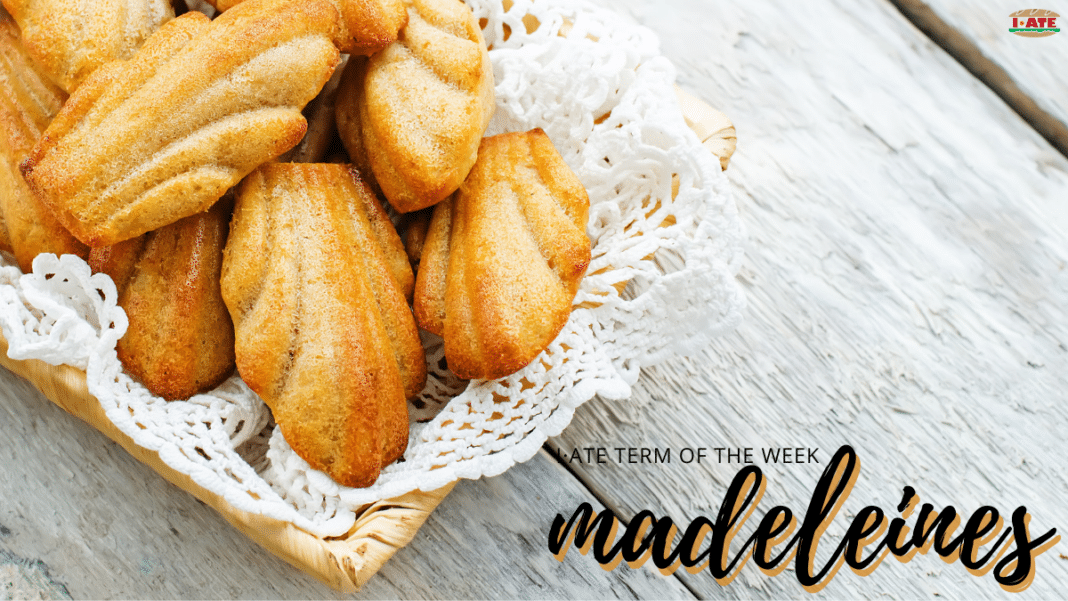No sooner had the warm liquid mixed with the crumbs touched my palate than a shudder ran through me and I stopped, intent upon the extraordinary thing that was happening to me. An exquisite pleasure had invaded my senses, something isolated, detached, with no suggestion of its origin. […] And suddenly the memory revealed itself. The taste was that of the little piece of madeleine which on Sunday mornings at Combray (because on those mornings I did not go out before mass), when I went to say good morning to her in her bedroom, my aunt Léonie used to give me, dipping it first in her own cup of tea or tisane.[1]
Marcel Proust. Swann’s Way, In Search of Lost Time. 1913
 A single mouthful of a soft madeleine dipped in tea has the power to send Marcel Proust back into a vivid memory of his childhood in Combray, when his aunt offered him a bite of the very same snack. This evocative episode of the novel In Search of Lost Time has become so popular in literature that the metaphor “Proust’s madeleine” is still today employed to depict any taste, smell, or sensation capable to trigger recollections from the supposedly forgotten past.
A single mouthful of a soft madeleine dipped in tea has the power to send Marcel Proust back into a vivid memory of his childhood in Combray, when his aunt offered him a bite of the very same snack. This evocative episode of the novel In Search of Lost Time has become so popular in literature that the metaphor “Proust’s madeleine” is still today employed to depict any taste, smell, or sensation capable to trigger recollections from the supposedly forgotten past.
These traditional French cakes, also known as petites madeleines for their small size, are described by the author as “squat” and “plump”, looking as though it “had been moulded in the fluted valve of a scallop shell”. Their uniqueness lies in effect in its distinctive shell shape with a little round bump in the middle. The recipe is quite simple, mixing eggs, flour, sugar, and butter in almost equal parts by weight; some even add lemon zest for a fresher taste. The final flavour and consistency vaguely resemble those of a sponge cake.
Madeleine – a Cake with a History
Multiple legends and stories intertwine when it comes to the origins of these elegant snacks. The most famous suggests they were born in 1755 in the town of Commercy, in north-eastern France, in the castle where Stanisław Leszczyński, exiled King of Poland, and then Duke of Lorraine, had sought refuge. One day when the duke was holding a reception, a young servant named Madeleine Paulmier offered to prepare a recipe she had been given by her grandmother after the main cook had left before preparing dessert. Stanisław was so charmed by the small, shell-shaped cakes she baked that he decided to send some to his daughter, Maria, wife of Louis XV, who began serving them to the court in Versailles.
Other versions link the madeleines with the pilgrimage to Santiago de Compostela and with another “Madeleine”, who is said to have offered little cakes in the shape of a scallop shell to the pilgrims making their way to Galicia.
Sources
[1] Original: Mais à l’instant même où la gorgée mêlée des miettes du gâteau toucha mon palais, je tressaillis, attentif à ce qui se passait d’extraordinaire en moi. Un plaisir délicieux m’avait envahi, isolé, sans la notion de sa cause. […] Et tout d’un coup le souvenir m’est apparu. Ce goût c’était celui du petit morceau de madeleine que le dimanche matin à Combray (parce que ce jour-là je ne sortais pas avant l’heure de la messe), quand j’allais lui dire bonjour dans sa chambre, ma tante Léonie m’offrait après l’avoir trempé dans son infusion de thé ou de tilleul.
Marcel Proust. À la recherche du temps perdu, Tome 1: Du côté de chez Swann. 1913.
Marcel Proust. In Search of Lost Time (sometimes translated as Remembrance of Things Past), Volume 1: Swann’s Way. English translation by C. K. Scott Moncrieff.
Marmiton. Recette des madeleines. [ONLINE]. Available at: https://www.marmiton.org/recettes/recette_madeleines-faciles_17700.aspx [Accessed 06/09/2020]
À la cloche Lorraine. Un peu d’histoire. [ONLINE]. Available at: http://www.madeleine-commercy.com/histoire_madeleine.php [Accessed 07/09/2020]
Centre de recherche et d’étude de la boulangerie et de ses compagnonnages. La madeleine. 2015. [ONLINE]. Available at: https://levainbio.com/cb/crebesc/la-madeleine/ [Accessed 07/09/2020]
Culture Trip. 2018. A brief history of the French madeleine. [ONLINE]. Available at: https://theculturetrip.com/europe/france/articles/brief-history-french-madeleine/
 Written by Irene Zanardi, Schuman Trainee at the Euramis Pre-Translation Unit. She holds a Bachelor’s in Intercultural Linguistic Mediation and a Master’s in Specialised Translation and Terminology.
Written by Irene Zanardi, Schuman Trainee at the Euramis Pre-Translation Unit. She holds a Bachelor’s in Intercultural Linguistic Mediation and a Master’s in Specialised Translation and Terminology.

